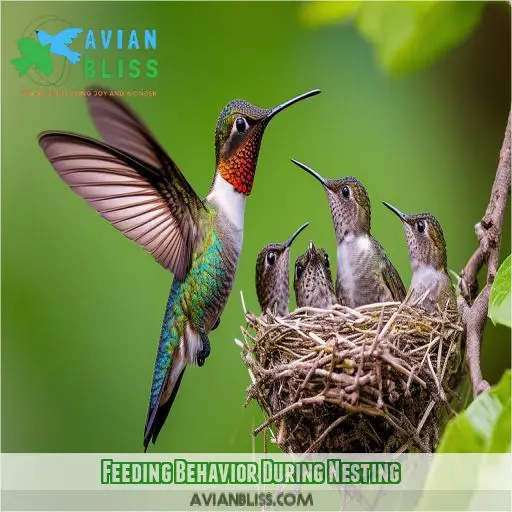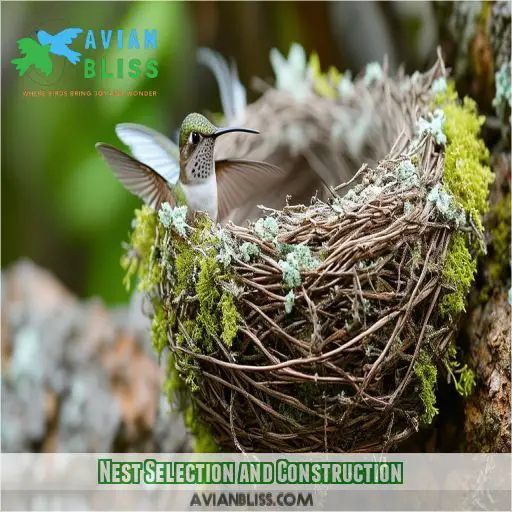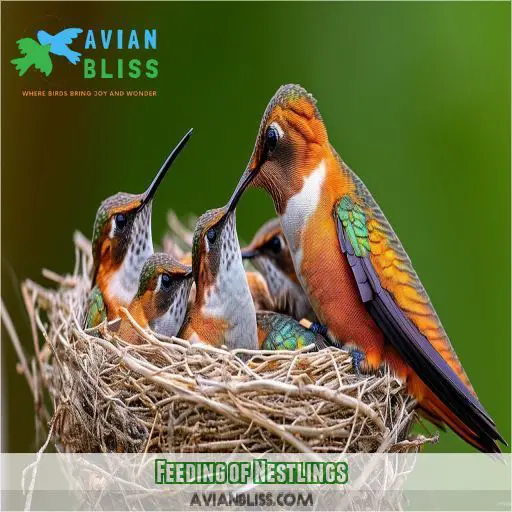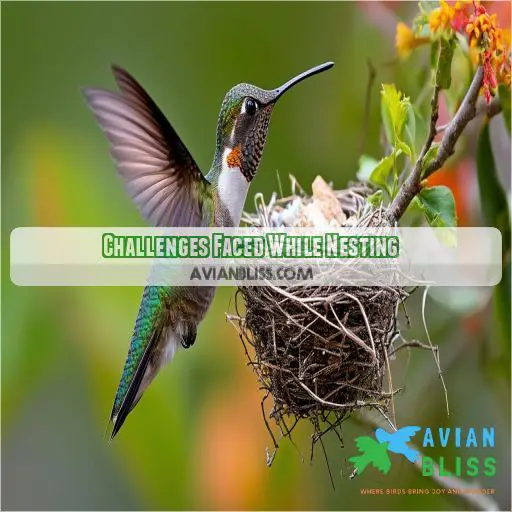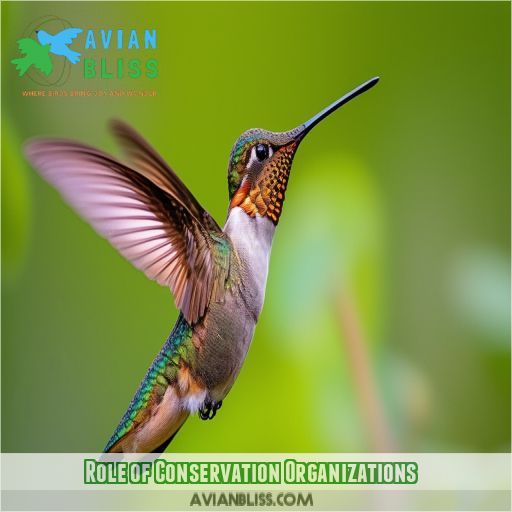This site is supported by our readers. We may earn a commission, at no cost to you, if you purchase through links.
 Did you know that female hummingbirds can lay eggs weighing up to 10% of their body weight? When pregnant, these tiny marvels undergo remarkable behavioral changes.
Did you know that female hummingbirds can lay eggs weighing up to 10% of their body weight? When pregnant, these tiny marvels undergo remarkable behavioral changes.
You’ll discover the fascinating nesting secrets of pregnant hummingbirds, from their precise nest construction to their feeding habits. We’ll explore how they select materials, camouflage their nests, and care for their young.
Understanding pregnant hummingbird behavior not only satisfies your curiosity but also helps you appreciate the intricate balance of nature in your own backyard.
Table Of Contents
- Key Takeaways
- Feeding Behavior During Nesting
- Nest Selection and Construction
- Selection of Nesting Material
- Incubation Duration and Technique
- Feeding of Nestlings
- Challenges Faced While Nesting
- Renesting and Double Brooding
- Migration Considerations and Nesting
- Post-Nesting Care and Behavior
- Role of Conservation Organizations
- Frequently Asked Questions (FAQs)
- Do female hummingbirds feed while nesting?
- How do you know if a bird is pregnant?
- What is the nesting behavior of a hummingbird?
- What is the survival rate of baby hummingbirds?
- Do pregnant hummingbirds change color or appearance?
- How do male hummingbirds interact with pregnant females?
- Can pregnant hummingbirds hover as effectively?
- Do pregnant hummingbirds become more territorial?
- Are there specific flowers pregnant hummingbirds prefer?
- Conclusion
Key Takeaways
- Talk about a superwoman! Female hummingbirds can lay eggs weighing up to 10% of their body weight, then turn into aerial acrobats as they zip from flower to flower, fueling up for the demanding task of motherhood.
- These pint-sized architects are choosy about their digs, often selecting horizontal branches 10-40 feet high. They’re not just throwing sticks together either – we’re talking spider silk, plant down, and lichen for the ultimate camouflaged crib.
- Mother hummingbirds are the ultimate multitaskers, spending nearly every waking moment either incubating their eggs or playing "meals on wings" for their growing chicks. It’s like running a 24/7 airborne diner!
- These tiny titans face big challenges, from egg predators to maintaining the perfect nest temperature. But don’t count them out – they’re tough as nails and often bounce back from nest failures, sometimes even raising two broods in one season. Talk about overachievers!
Feeding Behavior During Nesting
When you’re watching a pregnant ruby-throated hummingbird, you’ll notice her feeding behavior ramps up dramatically. She’s not just eating for herself anymore; those tiny eggs demand a lot of energy. You’ll see her darting from flower to flower, sipping nectar like there’s no tomorrow. It’s a delicate balance, though. She’s got to keep herself fueled while preparing for the demanding task of nestling care.
Once the eggs hatch, her feeding frenzy kicks into high gear. She’ll visit the nest frequently, regurgitating a mix of nectar and insects into her chicks’ mouths. It’s not the prettiest sight, but it’s incredibly efficient. The diversity of food sources she taps into is essential for her offspring’s growth.
Between feedings, she’ll maintain impeccable nest hygiene, ensuring her little ones stay healthy in their cozy home.
Nest Selection and Construction
You’ll find pregnant hummingbirds carefully selecting their nesting sites, often choosing horizontal branches that offer protection and stability. They’ll then construct their tiny nests using spider webs as a binding agent, incorporating plant down for softness and adorning the exterior with lichen for effective camouflage.
Preferred Nesting Sites
You’ll find female hummingbirds are picky about their nesting spots. They prefer horizontal branches or large limbs, often in deciduous trees. These tiny architects choose sites 10-40 feet high, sheltered from wind and rain.
The nest’s size? Barely larger than a quarter! It’s a delicate balancing act between visibility and protection.
Their habitat preferences vary, but one thing’s certain: these feathered moms know how to pick prime real estate for their eggs.
Spider Web Usage
You’ll be astonished by how hummingbirds utilize spider webs in their nests. These diminutive architects gather silk threads, interweaving them into a pliable foundation. The adhesive silk functions like glue, binding plant down and other materials.
This ingenious design guarantees nest stability and egg protection. As single mothers, hummingbirds rely on this sturdy yet elastic structure to withstand their energetic movements during incubation and feeding.
It’s a testament to nature’s brilliant solutions for these iridescent flyers.
Camouflage With Lichen
You’ll be amazed at how hummingbirds use lichen for camouflage. After securing the nest with spider webs, these tiny architects adorn it with lichen, creating a masterpiece of concealment. Here’s how they do it:
- Select lichen color matching surrounding branches
- Choose nesting height balancing predator awareness and branch flexibility
- Strategically place lichen for best nest concealment
This pregnant hummingbird behavior showcases their incredible adaptability. As you’re bird watching, you might just miss these well-hidden nests!
Selection of Nesting Material
You’ll be amazed by the resourcefulness of pregnant hummingbirds as they gather nesting materials. They collect spider webs for structure, soft plant down for lining, and lichen for camouflage, creating a tiny, hidden masterpiece to cradle their eggs.
Spider Web Usage
You’ll be amazed by the ingenuity of hummingbirds in the realm of nest construction. They’re master architects, using spider silk as their primary building material. This remarkable choice offers both strength and flexibility, allowing the nest to expand as the chicks grow.
| Spider Web Usage | Benefits |
|---|---|
| Strength | Holds nest together |
| Elasticity | Allows nest expansion |
| Durability | Withstands weather |
| Adhesive | Binds other materials |
These tiny builders employ sophisticated web-building techniques, creating a cozy, expandable home for their offspring.
Plant Down Collection
After securing spider webs, you’ll see hummingbirds collecting soft plant down for their nests.
They’re picky about their nest location, choosing spots that offer protection for their brood.
You’ll notice them gathering fluffy materials from plants like cottonwood or dandelions. This down provides insulation and comfort for eggs and chicks.
It’s amazing how these tiny birds select just the right plant material for their cozy homes.
Lichen For Camouflage
You’ll be amazed at how hummingbirds use lichen for camouflage. After collecting plant down, they carefully select pieces of lichen to adorn their nests.
This clever camouflage technique helps protect their tiny homes from predators. The lichen blends seamlessly with the surrounding environment, making the nest nearly invisible.
It’s proof of these birds’ ingenuity and survival instincts. Nature’s tiny architects truly know how to keep their families safe!
Incubation Duration and Technique
Now that you’ve learned about the materials used in nest construction, let’s delve into the captivating world of hummingbird egg incubation. You’ll be astonished at the unwavering commitment these tiny mothers exhibit during this critical period.
Hummingbird moms are masters of egg temperature regulation, maintaining a comfortable environment for their developing chicks. They spend 50-55 minutes of every hour incubating their eggs, diligently monitoring chick growth through subtle changes in egg shape and weight. Their vigilance during incubation is truly extraordinary.
Here are three awe-inspiring facts about hummingbird incubation:
- Incubation lasts 14-16 days, demanding constant attention.
- Females utilize their body heat to sustain eggs at the optimal temperature.
- They’ve developed specialized nest sanitation techniques to safeguard their offspring.
While most hummingbird species don’t share incubation responsibilities, the female’s dedication to her future family is unwavering. You’ll gain a newfound appreciation for these tiny marvels of nature as you learn about their nesting secrets.
Feeding of Nestlings
As the tiny hummingbird chicks hatch, you’ll witness an incredible feat of parental care. The mother hummingbird’s feeding regimen is nothing short of remarkable. She’ll regurgitate a mixture of nectar and insects directly into her nestlings’ mouths, ensuring they receive the perfect balance of nutrients.
Here’s a breakdown of the feeding process:
| Time of Day | Regurgitation Frequency | Food Quantity |
|---|---|---|
| Morning | Every 15-20 minutes | 1-2 drops |
| Midday | Every 30-45 minutes | 2-3 drops |
| Evening | Every 20-30 minutes | 1-2 drops |
You’ll notice the mother’s dedication as she tirelessly forages for a diverse range of nectar sources and carefully selects insects to meet her chicks’ growing needs. This intensive feeding continues for about three weeks, with the frequency and quantity gradually increasing as the nestlings develop. It’s a delicate balance of nurturing and preparing them for their future independence.
Challenges Faced While Nesting
As you’ve learned about feeding nestlings, you’ll now discover the challenges hummingbirds face while nesting. Nest site defense is a constant battle, with these tiny warriors fiercely protecting their precious homes from intruders. Egg predation is a real threat, keeping mama hummingbird on high alert.
She’s got to maintain the perfect incubation temperature, a delicate balancing act between warmth and overheating. Nestling development is a race against time, with these little ones growing at an astonishing rate. You’d be amazed by their nestling vocalizations, tiny chirps that signal hunger or distress.
It’s not all smooth sailing for these feathered marvels. They’re up against the elements, predators, and the clock. But don’t worry – these determined birds have tricks up their sleeves to overcome these obstacles and guarantee their offspring’s survival.
Renesting and Double Brooding
Despite the challenges, hummingbirds are resilient little creatures. If a nest fails, you’ll often see females re-nesting within days. This determination is critical for their survival. Re-nesting frequency depends on factors like egg loss causes, which can include predation or severe weather.
Double-brooding, where a female raises two broods in one season, is more common than you might think. However, it’s not a universal behavior. Seasonal timeframes and geographic locations play significant roles in determining whether double-brooding occurs. In southern regions, where the breeding season is longer, you’re more likely to witness this phenomenon. For instance, hummingbirds in Florida might even attempt triple-brooding!
It’s proof of their adaptability and drive to ensure their species’ continuity. Remember, every successful brood is a small miracle in the realm of these tiny marvels.
Migration Considerations and Nesting
You’ll find that pregnant hummingbirds face unique challenges during migration and nesting. They must navigate long-distance flights while preparing to build nests and raise young, with some species even attempting double brooding in favorable conditions.
Long-Distance Flight Challenges
You’ve seen how hummingbirds can re-nest and even double-brood, but their challenges don’t end there.
These tiny marvels face incredible hurdles during migration. Energy expenditure is astronomical as they navigate wind patterns and cross the Gulf of Mexico. Food availability becomes essential for their survival.
They’ve developed impressive navigation techniques to guide them on their journey. It’s a demonstration of their resilience and determination.
Nest Site Selection
When selecting a nest site, hummingbirds consider:
- Safety from predators
- Proximity to food sources
- Protection from harsh weather
You’ll find these tiny architects favoring small branches or large limbs, expertly concealing their nests. They’re masters of camouflage, using lichen to blend in with surroundings. As the family grows, they’ll adjust the nest size, stretching it to accommodate their chicks. It’s a delicate balance of site preference and survival strategy.
Double-Brooding Possibilities
After selecting the perfect nest site, you might wonder if hummingbirds can raise more than one brood per season. Double-brooding is indeed possible, especially in warmer regions. Let’s explore the fascinating world of hummingbird reproduction:
| Factor | Impact | Consideration |
|---|---|---|
| Timing | Critical | Early spring start |
| Energy | High cost | Abundant food needed |
| Success | Variable | Weather dependent |
Double-brooding frequency varies, with southern hummingbirds more likely to attempt it. The environmental impact can be significant, affecting local ecosystems and food sources.
Post-Nesting Care and Behavior
After the strenuous journey of migration and nesting, you’d suppose hummingbirds would get a respite. But their work isn’t over yet! Post-nesting care is paramount for fledgling independence and double-brooding accomplishment. Here’s what happens after the chicks leave the nest:
- Fledglings hone their flying skills near the nest
- Mom continues to feed them for about a week
- Young birds learn to locate food sources independently
- Female may commence preparing for a second brood
- Conservation efforts prioritize protecting feeding areas
You’ll note the female’s devotion as she balances tending to her fledglings and potentially re-nesting. This period is a delicate balance of nurture and release. For some species, like those in warmer climates, double-brooding is prevalent. The female’s capacity to rear multiple broods in a season showcases her remarkable resilience and adaptability. It’s a proof of these tiny marvels’ resolve to guarantee their species’ survival.
Role of Conservation Organizations
As you marvel at the post-nesting care hummingbirds provide, it’s essential to recognize the role conservation organizations play in protecting these tiny wonders. Groups like the American Bird Conservancy and The Nature Conservancy are working tirelessly to safeguard hummingbird habitats. Through land acquisition and habitat protection efforts, they’re preserving vital breeding grounds and migration routes.
You can join the fight by supporting these organizations or getting involved locally. Remember, every bit helps! By protecting green spaces and creating hummingbird-friendly gardens, you’re giving these feathered acrobats a fighting chance.
It’s not just about the birds, though. Conservation efforts benefit entire ecosystems, from the tiniest insects to the tallest trees. So, next time you spot a hummingbird zipping by, take a moment to appreciate the hard work that goes into keeping their world spinning.
Frequently Asked Questions (FAQs)
Do female hummingbirds feed while nesting?
Yes, female hummingbirds feed while nesting. You’ll see them leave the nest for quick snacks, typically lasting 10-15 minutes. They’re efficient, balancing their own needs with incubation duties to keep their eggs warm and healthy.
How do you know if a bird is pregnant?
You can’t text a bird to ask if it’s expecting! Look for signs like increased appetite, weight gain, and nesting behavior. Observe changes in their appearance and activities. They’re not "pregnant," but preparing to lay eggs.
What is the nesting behavior of a hummingbird?
You’ll find hummingbirds building tiny, cup-shaped nests on tree branches. They’ll use spider silk, plant fibers, and lichen for camouflage. The female lays two pea-sized eggs and incubates them alone for about two weeks.
What is the survival rate of baby hummingbirds?
You’ll find that baby hummingbirds face tough odds. Only about 20-30% survive their first year. Predators, weather, and food scarcity pose significant challenges. It’s a proof of their resilience that any make it at all.
Do pregnant hummingbirds change color or appearance?
You won’t notice significant color changes in pregnant hummingbirds. Their appearance remains largely the same. However, you might observe subtle physical changes, like a slightly enlarged abdomen, as they prepare for egg-laying. Their behavior may become more focused on nesting activities.
How do male hummingbirds interact with pregnant females?
You’ll notice male hummingbirds tend to keep their distance from expectant females. They’re not exactly doting partners. Males focus on defending their territories, while pregnant females busily prepare for motherhood, gathering resources and building nests independently.
Can pregnant hummingbirds hover as effectively?
You’ll notice pregnant hummingbirds can still hover effectively. Their incredible flight abilities aren’t compromised, even with the extra weight. They’ll zip around, sipping nectar and catching insects, just like usual. It’s a marvel of nature’s design.
Do pregnant hummingbirds become more territorial?
You’ll notice pregnant hummingbirds become more territorial. They’ll fiercely defend their chosen nesting areas, chasing away intruders with impressive aerial maneuvers. This behavior guarantees they’ve exclusive access to nearby food sources for their growing offspring.
Are there specific flowers pregnant hummingbirds prefer?
Coincidentally, as you’re planting your garden, pregnant hummingbirds are seeking specific flowers. They’re drawn to tubular blooms rich in nectar, like trumpet honeysuckle and bee balm. You’ll notice they prefer red, orange, and pink hues.
Conclusion
Like delicate aerial ballerinas, pregnant hummingbirds choreograph an intricate dance of survival. You’ve now glimpsed the hidden world of these tiny marvels, from their spider web-adorned nests to their tireless dedication as mothers.
Understanding pregnant hummingbird behavior reveals nature’s ingenuity in action. By appreciating these remarkable creatures, you’ll gain a deeper connection to the vibrant ecosystem in your own backyard.

